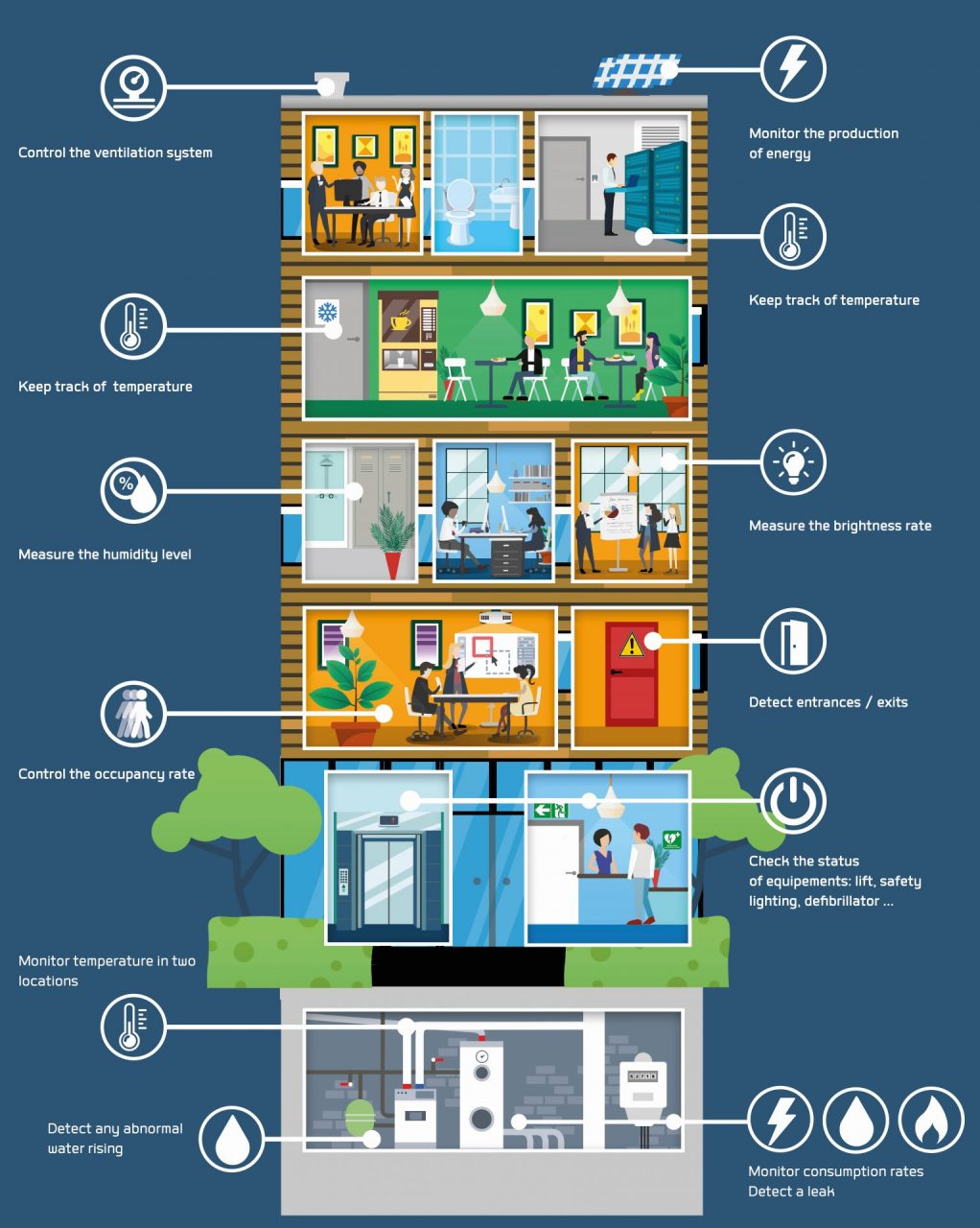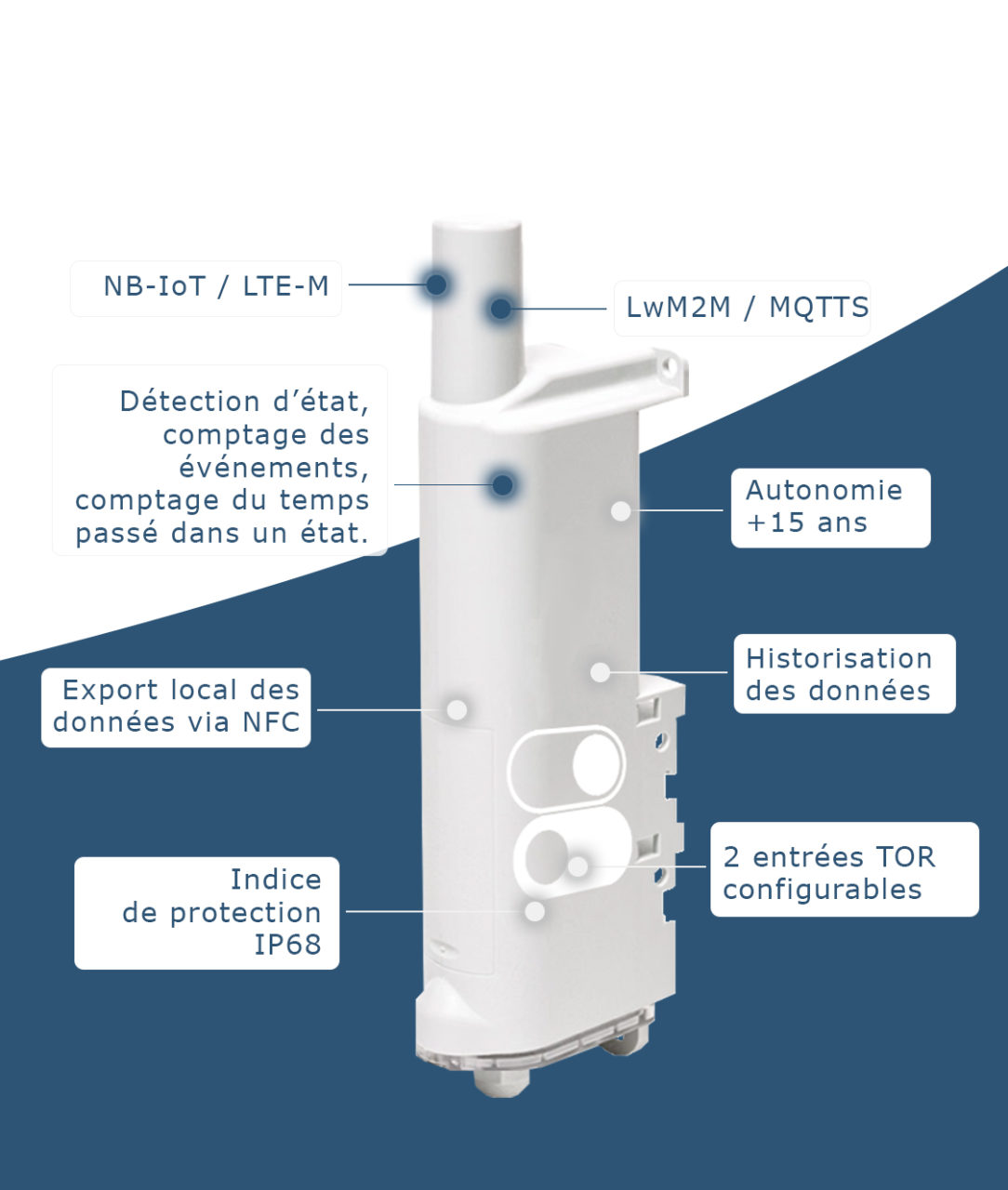WHAT IS SMART BUILDING?
The smart building, connected building or intelligent building.
In a smart building, the building usage data is collected and processed in order to improve the life of the building and also that of its occupants. The building becomes smarter and more automated: it can communicate with its users and with the outside world.
The principle is based on the use of sensors/actuators, which will collect a large number of data on life in the building: temperature, pressure, consumption, presence, air quality, luminosity, etc. The analysis of this data will make it possible to respond to the main challenges of smart building:

Improving the energy performance of the building

Optimize building management and maintenance

Guaranteeing the comfort and safety of users
KEY FIGURES OF THE SMART BUILDING
The market for smart buildings would generate $24.7 billion worldwide by 2021.
(Intelligent Building Systems et MarketsandMarkets, 2017)
The 3 main drivers of investment in smart buildings are:
Cost savings (44%)
Customer satisfaction (22%)
Improvement of maintenance (19%)
SMART BUILDING CHALLENGES
Whether it is tertiary, industrial, residential… the building is full of untapped data. All or part of the building may one day communicate and bring new information on the life and use of this building.
In a smart building these data are now retrieved and processed remotely in near real time. Their exploitation is a source of considerable optimization for any building manager.
Consumption of electricity, water, gas, leak detection, fluid level monitoring, presence detection, control of the rate of light, temperature, humidity, validation of the operating status of equipment … the possibilities are numerous and a combination of these data bring even more avenues of progress to the smart building.
Energy performance in a smart building
According to ADEM, buildings account for 43% of the world’s energy consumption, while the average occupancy rate of an office is commonly estimated at between 45% and 55%.
Reducing greenhouse gas emissions is a societal challenge. To meet this challenge, more and more national and international standards are being issued. For example, in France, the Tertiary Decree that came into force on October 1, 2019, requires the tertiary sector to gradually reduce energy consumption by 2050, through quantitative targets.
Reducing consumption requires above all better access to information and analysis of operations. Once the smart building data has been collected and analysed, concrete actions to optimise the use of these resources can be implemented. For example, this can be done by analysing the temperature of a room combined with heating control, or by studying the occupancy of a space and adapting the brightness. The analysis of fluids (water, gas, electricity, etc.) enables you to monitor your energy bill, detect leaks and act as quickly as possible to limit the associated losses.
Improving the overall energy performance of the building is the result of both reducing consumption and optimising the use of equipment according to the real needs of the building’s users.
And while one of the primary motivations is obviously to reduce the budget, reducing consumption is above all good for our environment.
The building sector is the most energy-intensive sector
of greenhouse gas (GHG) emissions
0 %
of French energy consumption
0 %
The objective is to reduce GHGs in France by a factor of 4 by 2050.
/ 0
Maintenance in a smart building
The operating and maintenance costs of a building represent 75% of its TCO (Total Cost of Ownership).
With the implementation of a smart building you can better understand the building’s equipment (heating, DHW (hot water) circuits, elevators, ventilation systems, safety equipment, etc.), optimize their maintenance, reduce operating costs and meet regulatory obligations. The data provided by the building allows operators to better understand it, to adapt their interventions to the real needs of the equipment and to gain in reactivity. The data provided by IoT sensors to professionals in the sector helps them make the right decisions at the right time.
Currently, maintenance interventions are either regularly scheduled, to check the good condition of the installations or to meet regulatory obligations, or corrective, carried out in response to needs when equipment fails. In a smart building, thanks to the data communicated by the equipment, these maintenance operations are carried out at the right time and quickly, which in particular makes it possible to reduce the expenses generated by non-functional equipment.
With Edge Computing and AI (Artificial Intelligence), the possibilities are even greater. By analyzing equipment lifecycles, maintenance can now be anticipated.
User comfort in a smart building
A building, whatever it is, is a place of life and passage. Optimising its proper functioning by making it more “intelligent” also means improving the comfort of those who live, work and move around…
The above-mentioned optimizations, to improve the energy performance or maintenance of the building, have a significant impact on the use of the building by its occupants. Here are some examples of IoT smart building applications to improve building comfort:
- The regulation of the indoor temperature by means of temperature and humidity sensors improves the well-being in residential buildings, hotels – restaurants, offices, etc…,
- Brightness control is an important factor in improving the quality of working life for employees (QWL),
- A better control of the proper functioning of ventilation systems prevents a deterioration of indoor air quality,
- By analysing the occupancy rate of rooms in office spaces, spaces can be reorganised to improve their use…
And there are more and more applications…
SMART BUILDING IN IMAGES

SMART BUILDING VOCABULARY
Smart Grid
The Smart Grid is an intelligent electricity distribution network. These networks are managed with computer tools to improve production, distribution and consumption. The final objectives are to know, manage, control and optimize the network.
QWL (Quality of Working Life)
“Conditions in which employees carry out their work, and their ability to express themselves and to influence the content of their work, determine the perception of the resulting quality of working life”. (National Interprofessional Agreement on Professional Equality and Quality of Life at Work (ANI)).
TBM Technical Building Management
The Building Management System (TBM) is a computer system for the control and supervision of all technical equipment generally installed in large commercial or industrial buildings. The data collected can come from various sources: heating, air conditioning, ventilation, electricity, alarms, etc.
The term BMS is also called BMS: Building Management System.
CTM Centralized Technical Management
The CTM corresponds to a level that can be described as lower than the CTM. It is based on the same principle and gives an overview of all the parameters of a single batch, such as electricity, for example.
Both BMS and BMS work with sensors, actuators and management interfaces.
BIM
Building Information Modeling or unique building information modeling or Digital Building Model (DBM) is a technology and processes associated together to produce, communicate and analyze construction models (Eastman, 2011). Thus, BIM can be defined as: a process of management and production of data; a unique model of the building; a “reasoning on one” concept single model”; a software because it works by integrating a series of software and a standard, thanks to IFCs (ISO 10303-21 exchange files). Although BIM makes design easier, it does not formalize it in the upstream phases. Thus, BIM extends over the life cycle of the building, but it does not manage it (Bouguessa, 2013). https://www.smartbuildingsalliance.org/travaux/lexique
20/06/2020
20 years
expertise to support you, from the diagnosis to the implementation of your solution


